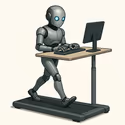VR / AR for Monitor Replacement: Quest 3, Bigscreen Beyond 2, and AR Glasses
Using VR/AR headsets as monitor replacements is now viable for specific professionals, but the market is fragmented. No single device is a clear winner for everyone.
- Bigscreen Beyond 2: This PC-tethered headset provides the best visual quality and comfort. Its dual 2560x2560 Micro-OLED displays achieve a "retina" 32 PPD, making text perfectly clear. At only 107 grams with a custom-molded face cushion, it is comfortable for all-day use. Its critical flaw is the complete lack of passthrough cameras, making it usable only for expert touch-typists.
- AR Glasses (Xreal, Viture, Rokid): These are the best solution for mobile work. Weighing ~72-79g, they connect via USB-C to a laptop or phone, creating a large, private, sharp virtual screen. The Viture Pro XR has an effective 49 PPD. While their field of view is smaller, software like Xreal's Nebula can create a multi-monitor setup, making them ideal for travelers.
- Meta Quest 3: The consumer market leader is a decent entry point but compromised for serious work. Its key strength is full-color passthrough, letting you see your keyboard. However, its 25 PPD (Pixels Per Degree) on LCD screens is not "retina" sharp, causing eye strain over long sessions. The headset is also front-heavy, requiring a third-party strap for comfort. The cheaper Quest 3S (20 PPD, Fresnel lenses) is unsuitable for work.
- Other Brands: ByteDance's Pico devices lack official US/EU support and have a weak software library, making them a risky choice.
Comparison: Clarity and Comfort
A device's value depends on text clarity (PPD, display type) and long-term comfort (weight, fit).
- Clarity Winner: Bigscreen Beyond 2 (32 PPD, Micro-OLED).
- Comfort Winner: Bigscreen Beyond 2 (107g, custom fit).
- Clarity Runner-Up: AR Glasses (up to 49 PPD in a focused view).
- Comfort Runner-Up: AR Glasses (~75g, though can cause pressure on nose/ears).
- Laggard (Both): Meta Quest 3 (25 PPD, 515g front-heavy design).
Visual Fidelity Comparison (2025)
| Device | Peak PPD | Resolution (per-eye) | Display Type | Lens Type | Analyst Grade |
|---|---|---|---|---|---|
| Bigscreen Beyond 2 | 32 | 2560x2560 | Micro-OLED | Pancake | A+ |
| Viture Pro XR | 49 | 1920x1080 | Micro-OLED | N/A | A- |
| Meta Quest 3 | 25 | 2064x2208 | LCD | Pancake | B |
| Meta Quest 3S | 20 | 1832x1920 | LCD | Fresnel | F |
All-Day Comfort Comparison (2025)
| Rank | Device | Headset Weight | Strap Design (Default) | Analyst Grade |
|---|---|---|---|---|
| 1 | Bigscreen Beyond 2 | 107g | Ultralight Soft Strap | A+ |
| 2 | AR Glasses (Xreal/etc.) | ~72-79g | Glasses Frame | A- |
| 3 | Meta Quest 3 | 515g (est.) | Poorly balanced soft strap | C- |
Software and Workflows
For displaying a PC screen, Virtual Desktop is the best app for solo professionals. It is stable, a one-time ~$20 purchase, and supports software-driven multiple monitors. Immersed is better for teams needing collaboration but is more complex and subscription-based.
- Programmer Workflow: Bigscreen Beyond 2, a powerful PC, and Virtual Desktop for a distraction-free, ultra-sharp multi-monitor setup. Requires touch-typing ability.
- Mobile Worker Workflow: AR glasses (Xreal/Viture) with a laptop for a portable, private, multi-screen workspace anywhere.
- 3D Artist Workflow: Meta Quest 3 for its good passthrough and 6DoF controllers, allowing artists to sculpt models in 3D space while seeing their physical desk.
Future: Valve Deckard
The rumored Valve Deckard could disrupt the market in 2026. Leaks suggest it will be a hybrid headset, combining the best features of current devices:
- Design: Standalone like Quest 3, with a lossless DisplayPort connection for high-end PCVR use.
- Visuals: High-resolution Micro-OLED displays and eye-tracking.
- OS: A VR version of SteamOS, providing a massive content library.
- Price/Release: ~$1,200, targeting a late 2025 to mid-2026 release.
If these leaks are accurate, the Deckard would resolve the market's main compromise (visuals vs. convenience), making it the superior choice for most professional and gaming users and rendering current devices obsolete.
Recommendation
Buy now if:
- You are a mobile worker. Buy Xreal or Viture AR glasses. They solve a specific problem well and are a good investment today.
- You are a programmer who is an expert touch-typist. Buy the Bigscreen Beyond 2 for its unmatched clarity and comfort.
Wait if:
- You are anyone else. This includes most generalist professionals, creatives, and users wanting a single device for work and gaming. Current options are too compromised. Waiting for the Valve Deckard is the best strategic decision, as it promises to be a generational leap.

Long coding sessions lead to physical fatigue and mental fog. A walking desk keeps you alert and focused, preventing costly bugs and burnout.Stay focused and healthy during long coding sessions.Get the factsGet the facts